Check out the camera performance and battery life of the iPhone 16 Pro, which can now shoot 48MP ultra-wide-angle photos and 4K 120fps movies

Apple's '
iPhone 16 Pro and iPhone 16 Pro Max - Apple (Japan)
https://www.apple.com/jp/iphone-16-pro/
The specs of the iPhone 16 Pro are compared with the iPhone 15 Pro and iPhone 16 in benchmark tests in the following article.
Should I upgrade to the iPhone 16 Pro with A18 Pro? We compared the benchmark results with the iPhone 15 Pro and iPhone 16 - GIGAZINE

◆I tried taking photos with the iPhone 16 Pro
The major improvements on the iPhone 16 Pro camera from the previous generation are the addition of camera controls and the 48MP ultra-wide-angle camera. Of these, the camera controls are also available on the lower-end iPhone 16, and we've taken a closer look at them in the article below.
'Camera Control' is a new feature that allows you to adjust camera settings without touching the screen on the iPhone 16, but it may take some time to get used to it - GIGAZINE

The following images are examples of photos taken with the iPhone 16 Pro. You can see the original image by clicking on the thumbnail image.
Tsutenkaku Tower in Shinsekai, Osaka, photographed with an iPhone 16 Pro at 1x magnification.

This is what it looks like at 2x magnification.
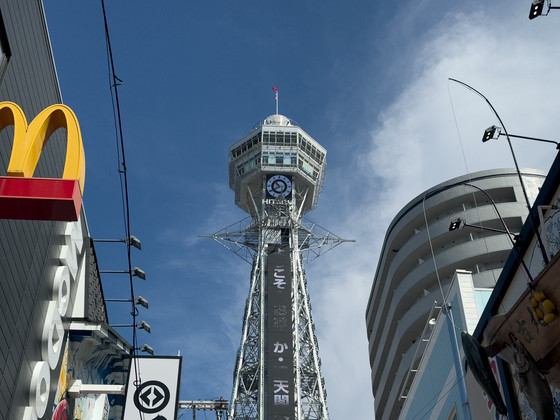
Below is a photo of Tsutenkaku taken from the same position with the iPhone 15 Pro at 3x magnification. The previous generation iPhone 15 Pro had a maximum telephoto camera zoom of 3x, so the iPhone 16 Pro can now take clearer shots of objects further away.
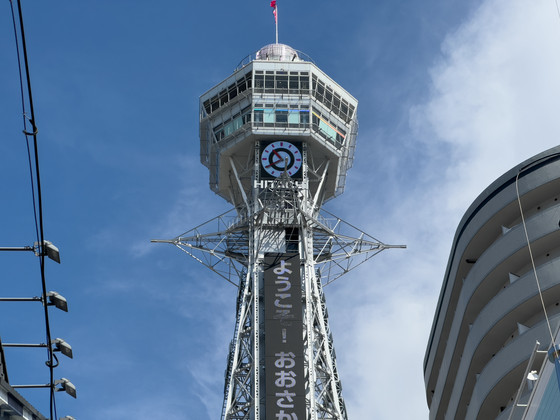
In addition, while the iPhone 15 Pro's 0.5x ultra-wide-angle camera could shoot at 12MP (4032 x 3024 pixels), the iPhone 16 Pro's ultra-wide-angle camera can now shoot at 48MP (8064 x 6048 pixels). Below are photos taken with the iPhone 16 Pro's ultra-wide-angle camera.

Below is a photo taken with the iPhone 15 Pro's ultra-wide-angle camera at the same position and angle.

Since the difference is only in resolution, it is difficult to tell the difference at a glance, but if you zoom in to the same degree on the sign in the photo above on an iPhone 15 Pro (left) and an iPhone 16 Pro (right), you can see that the letters on the sign are blurry on the iPhone 15 Pro.

Photographed Osaka's Shinsekai area with an ultra-wide-angle camera.

Photographed at 1x magnification in a slightly dark shopping street.

A plastic model photographed in macro mode at 1x magnification.

I took a photo of a vending machine at night in night mode with a magnification of 1x. It was nighttime so the surroundings were quite dark, but the 2-second exposure resulted in a fairly bright photo.

Below is a photo of a bicycle parking lot taken in night mode with the ultra-wide-angle camera. There were no lights in this bicycle parking lot, so it was almost pitch black, but the night mode made it bright enough to clearly see the spokes of the bicycle. Note that when shooting in night mode, the image is taken at 12MP (4032 x 3024 pixels).

◆ I shot a 4K 120fps movie
The iPhone 16 Pro can now shoot movies at 4K and 120fps. Not only can you shoot slow-motion movies using the original Camera app, but you can also select the 4K and 120fps setting for regular movie shooting.
The following movie was shot on an iPhone 16 Pro at 4K and 120 fps, showing the scenery flowing through the train window, and was edited and connected at three different speeds: normal speed, half speed, and quarter speed. Due to YouTube's specifications, 120 fps is automatically converted to 60 fps, but half speed of a 120 fps movie is 60 fps, which is as smooth as normal speed. In addition, the quarter speed part has a frame rate equivalent to 30 fps.
◆I checked the battery life and charging time
According to the official specifications , the iPhone 16 Pro's battery life is up to 22 hours for video playback (streaming), but the resolution of this 'video' is unknown. So, to check the actual battery life, we streamed a 4K video with the screen brightness at maximum and the volume at maximum from a 100% battery level to see how long the battery lasted.
The following movie shows a time-lapse shot from when playback started until the battery ran out. The video started playing at 18:00, and the battery reached 0% at about 1:31, about 7 hours and 30 minutes later.
I tried streaming 4K video on the iPhone 16 Pro and measuring the battery life - YouTube
The battery level graph on the iOS battery management screen looks like this:
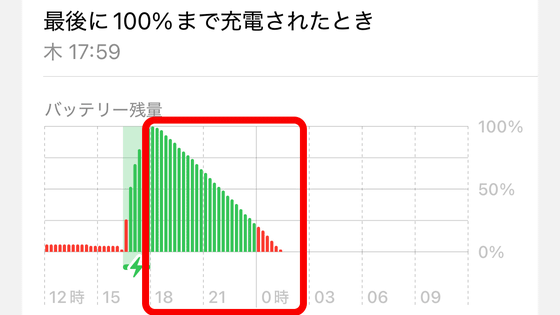
Next, I measured the charging time from 0% to 100%. I used

The battery recovered to 50% in 30 minutes from the start of charging, which was in line with the official specifications of 'maximum 50% charge in about 30 minutes.' Input power was 15.00V x 1.070A = 16.050W.

After one hour of charging, the battery had recovered to 82%. The input power at this point was 4.865V x 1.407A = approximately 6.845W.
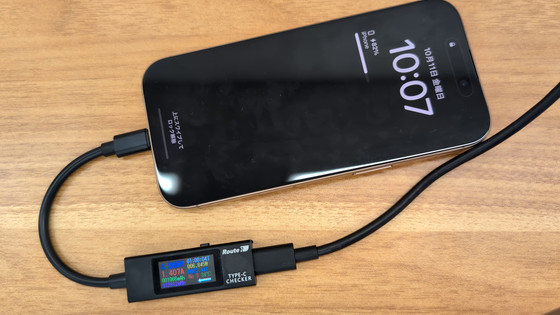
Charging was completed after 1 hour and 35 minutes. The accumulated current was 1658mAh and the accumulated power was 17,083mWh, so the average voltage was calculated to be about 10V. Also, according to
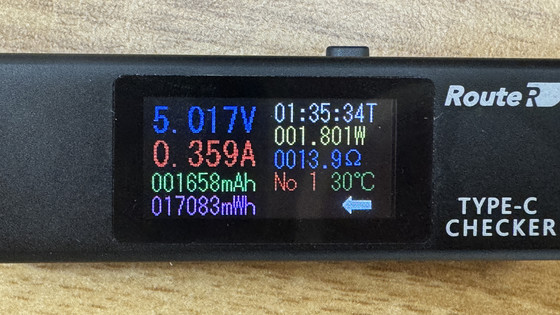
The graph below shows the battery level (blue, in %) and input power (red, in W) over 10-minute intervals. Immediately after charging begins, charging occurs at around 20 W, and as the battery charges, the power is reduced.
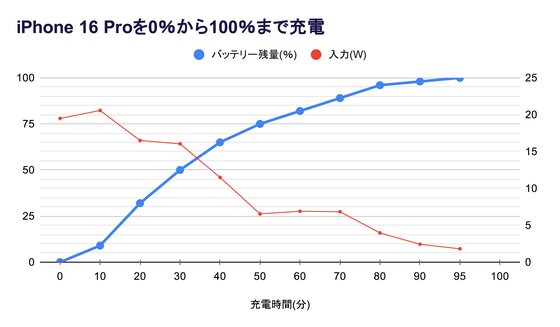
Summary
An editorial staff member who usually uses the iPhone 15 Pro actually used the iPhone 16 Pro for a few weeks and felt that although the specs have improved from the iPhone 15 Pro, there are few points where a big change can be felt in everyday use. Certainly, the performance of the camera has improved, and it is now possible to shoot with 5x zoom, but even if the ultra-wide-angle camera evolves to 48MP, the benefit is hardly felt, and there were no scenes that seemed to have evolved from the iPhone 15 Pro, especially when shooting things around you or scenery. Although the range of video shooting for 4K / 120fps movies is wider, there are few situations in everyday life where 4K / 120fps movies are taken, so to be honest, the iPhone 15 Pro or iPhone 16 are sufficient for general use. As for battery life, it lasts for more than a day with general use, so it seems that it can be operated without any problems.
Related Posts:





